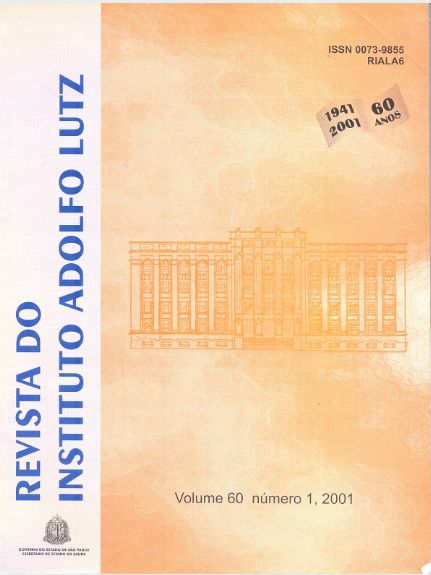Abstract
Among the enteric pathogens that attack patients with the human immunodeficiency virus (HIV) are opportunistic protozoans Cryptosporidium spp and Isospora belli. The purpose of this investigation was to establish the frequency of cryptosporidiosis and isosporidiosis in HIV seropositives patients in Ribeirão Preto region. From July 1990 to June 1997 in Adolfo Lutz Institute - Ribeirão Preto, 3340 stool samples were examined from 1833 symptomatic and asymptomatic patients, with ages ranging between 10 months and 55 years, attended in Ribeirão Preto AIDS Outpatient Departaments. The frequency of these protozoans among all the examined stool samples was 9,3%. We observed 207 (11,3%) patients with these parasites. Cryptosporidium spp was identified in 117 (6,4%) patients, Isospora belli in 81(4,4%) and 09 (0,5%) patients were infected by both parasites.
References
1. Agnew, D.G. et al. Cryptosporidiosis in Northeastern Brazilian Children: Association with increased diarrhea morbidity. J. Infec. Diseases, 117(3): 754-760, 1998.
2. Baraldi, S.R.; Marques, E.G.L.; Dias, R.M.D.S. Ocorrência de Cryptosporidium parvum e Isospora belli na região de Campinas, SP. Rev. Inst. Adolfo Lutz, 58(1): 97-103,1999.
3. Casemore, D.P. Epidemiological aspects of human crytosporidiosis. Epidemiol. Infections, 104: 1-2,1990.
4. Cimerman, S.; Cimerman, B. Isosporíase. Laes & Haes, 104: 154-156, dez96/ jan97.
5. Current, W.L.; Garcia, L.S. Cryptosporidiosis. Clin. Microbiol. Reviews, 4(3): 325-358, 1991.
6. De Hovitz, J.A. et al. Clinical manifestation and therapy of Isospora belli infection in patients with the Acquired Immunodeficiency Syndrome. New England J. Med., 315(2): 87-90, 1986.
7. Dias, R.M.D.S. et al. Cryptosporidiosis among patients with Acquired Immunodeficiency Syndrome (AIDS) in the county of São Paulo, Brazil. Rev. Inst. Med. trop. São Paulo, 30(4): 310-312, 1988.
8. Dias, R.M.D.S. et al. Enteroparasitoses em pacientes acometidos pela Síndrome da Imunodeficência Adquirida (AIDS/SIDA). Rev. Inst. Adolfo Lutz, 48(1/2): 63-67, 1988.
9. Foudraine, N.A. et al. Improvement of chronic diarrhoea in patients with advanced HIV-1 infection during potent antiretroviral therapy. AIDS, 12(1): 35-41, 1998.
10. Fundação Sistema Estadual de Análise de Dados (SEADE). Características dos Serviços de Abastecimento de Água, Esgotamento Sanitário e Coleta de Lixo do Estado de São Paulo, 1996, [http://www.seade.gov.br/cgi-bin/homev98/cadastro ksh]. 4 de março 2000.
11. Garlipp, C.R.; Bottini, P.V.; Teixeira, A.T.L.S. The relevance of laboratory of human cryptosporidiosis and other coccidia. Rev. Inst. Med. trop. São Paulo, 37(5): 467-469, 1995.
12. Guimarães, M.D.C. Estudo temporal das doenças associadas à AIDS no Brasil, 1980-1999. Cad. Saúde Públ. (Rio de Janeiro), 16(supl. 1): 21-36, 2000.
13. Guizeline, E.; Amato Neto, V. Pesquisa de oocistos de Cryptosporidium sp nas fezes diarréicas de aidéticos e de crianças e adultos imunocompetentes em São Paulo. Rev. Hosp. Clín. Fac. Med. São Paulo, 47(3): 150-152, 1992.
14. Havens, P.L.; Davis, J.P. Cryptosporidium and Cryptosporidiosis. Seminars in Pediatric Infectious Diseases, 7(4): 250-257, 1996.
15. Marsall, M.M. et al. Waterborne protozoan pathogens. Clin. Microbiol. Reviews, 10(1): 67-85,1997.
16. Martins, C.A.P.; Guerrant, R.L. Cryptosporidium and Cryptosporidiosis. Parasitol. Today, 2(2): 434-436, 1995.
17. Merck Sharp & Dome. AIDS Novos horizontes. Office Editora e Publicidade Ltda., ano I, nº 1, p.3; 8-9. São Paulo, S.P.,1999.
18. Moreira, E.D. JR. et al. Identificação de Isosporíase em pacientes comSíndrome de Imunodeficiência Adquirida em Salvador, BA. Rev. Soc. Bras. Med. trop., 24(1): 61-62, 1991.
19. Moura, H. et al. Enteric parasites and HIV infection; Occurrence in AIDS patients in Rio de Janeiro, Brazil. Mem. Inst. Oswaldo Cruz, 84(4): 527 - 533, 1989.
20. Rodrigues, J.L.N. et al. Prevalência de criptosporidiose na síndrome diarréica do paciente HIV positivo. Rev. Assoc. Méd. Bras., 37(2): 79-84, 1991.
21. Sauda, F.C. et al. Prevalence of Cryptosporidium sp and Isospora belli among AIDS patients attending Santos Reference Center for AIDS, São Paulo, Brazil. J. Parasitol., 79(3): 454-456, 1993.
22. Secretaria de Estado da Saúde. Programa DST/AIDS. Manual de Normas para Indicação e Dispensação de Antiretrovirais para Portadores do HIV/AIDS no Estado de São Paulo. 21p, 1996.
23. Soave, R.; Johnson Jr., W.R. Cryptosporidium and Isospora belli infections: AIDS commentary. J. Infec. Diseases, 157(2): 225-229, 1988.
24. Tzipori, S. Cryptosporidiosis in perspective. Advances Parasitol., 27: 67-129, 1988.
25. Tzipori, S. Cryptosporidiosis: Laboratory investigations and chemoterapy. Advances Parasitol., 40: 187-221, 1998.
26. Vakil, N.B. et al. Biliary cryptosporidiosis in HIV-infected people after waterborne outbreak of cryptosporidiosis in Milwaukee. New England J. Med., 334: 19-23, 1996.
27. Wuhib, T. et al. Cryptosporidial and Microsporidial infections in Human Immunodeficiency VirusInfected patients in Northeastern Brazil. J. Infec. Diseases, 170: 494-497, 1994.

This work is licensed under a Creative Commons Attribution 4.0 International License.
Copyright (c) 2001 Instituto Adolfo Lutz Journal
